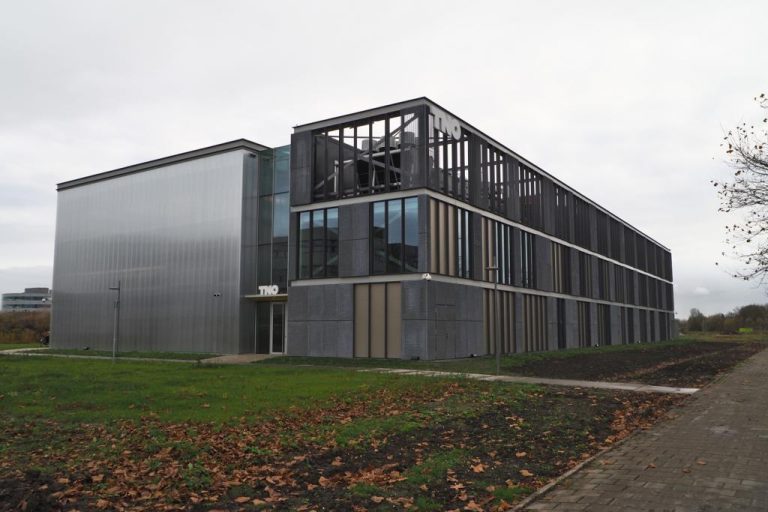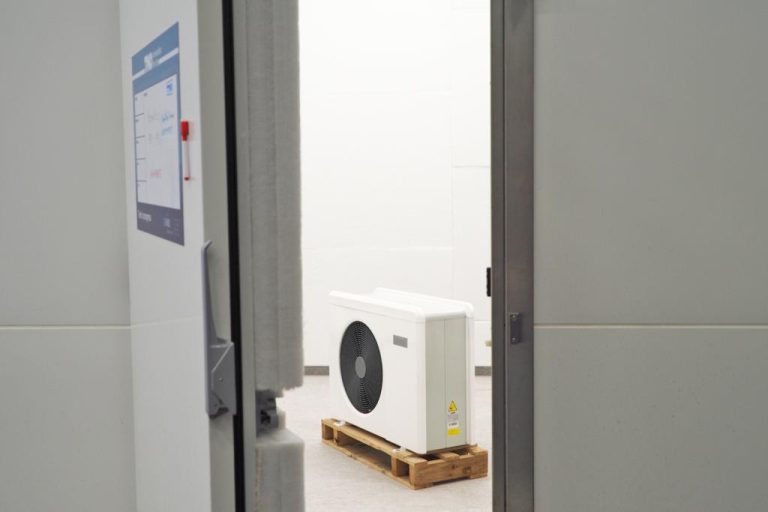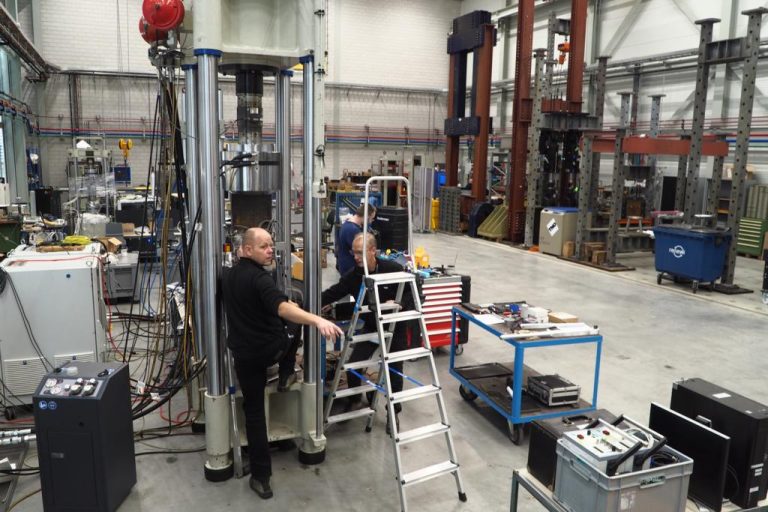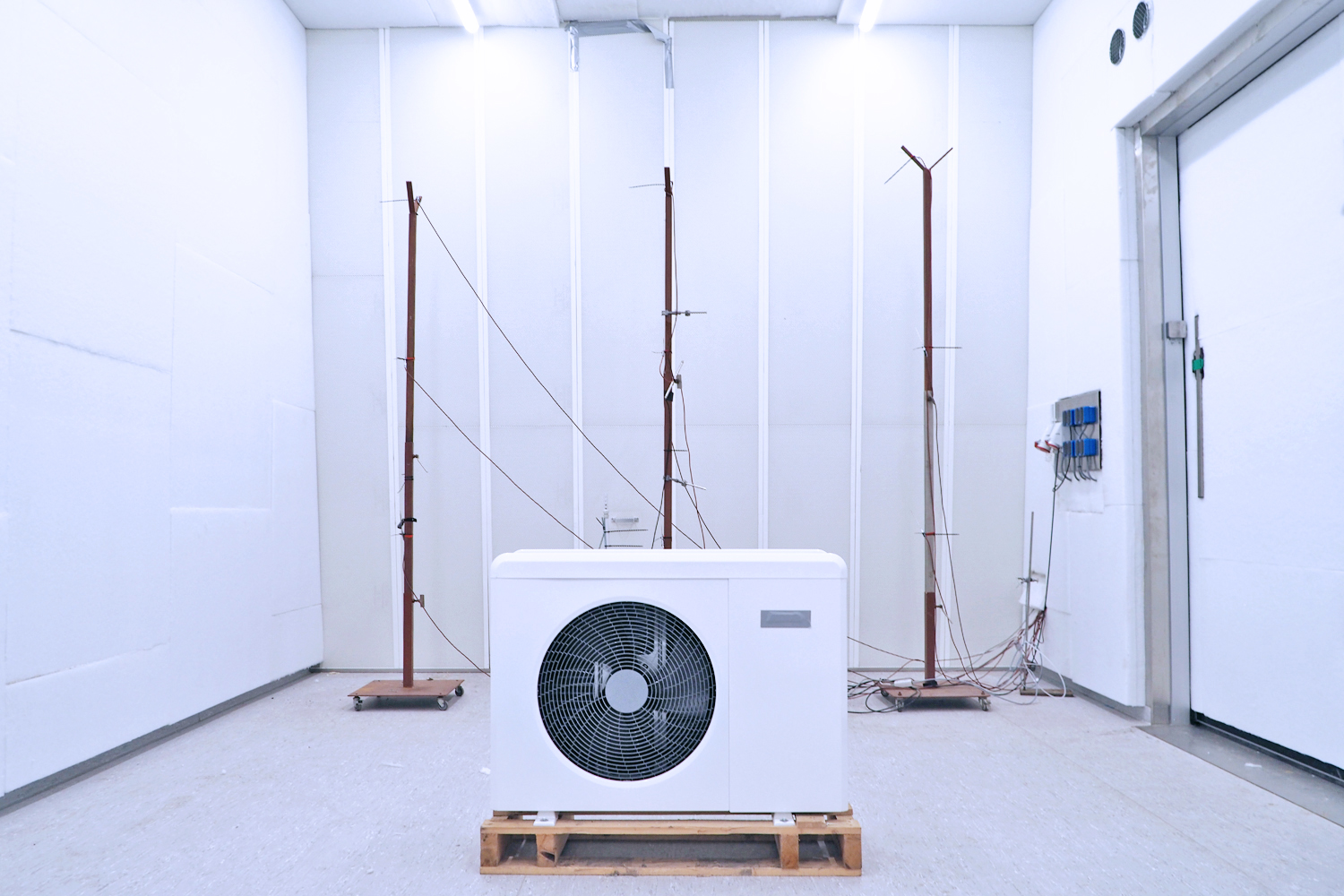The TNO Construction Innovation Lab explores the future of construction with renewable raw materials and gasless heating. Delta took a look in the brand new building.
Are heat pumps a good alternative to the central heating boiler? TNO is testing them in special climate chambers in the Building Innovation Lab (Photo: Jos Wassink)
Campus South is expanding steadily. The TNO Bouwinnovatielab, which opened at the beginning of October 2021, is located between the Holland PTC proton clinic and the NEXT building for scale-ups. The Bouwinnovatielab contains climate chambers, workshops and laboratories. There are presses that crush stones, a trolley that tests road surfaces by driving back and forth 10,000 times, and tensile testing machines that lash steel test pieces until they collapse after weeks or months. In rooms the size of half a gymnasium, the climate can be regulated to be a cold winter or a scorching hot summer. The four rooms are built in pairs for simultaneous adjustment of indoor and outdoor climate. This is a unique and realistic test location for heat pumps and heat recovery systems.

The TNO Construction Innovation Lab is a newcomer to the south campus. (Photo: Jos Wassink)
No more gas
In the coming decades, many central heating boilers will have to make way for heat pumps that provide gas-free and electric heating. “The existing buildings are the biggest problem,” says Richard Kemp, heat pump specialist at TNO. “You should naturally insulate older houses well before you start heating them with a heat pump. But what if it freezes to -10 degrees for a fortnight, will the heat pumps still keep the house warm?” No one knows.
Heat pumps transfer heat from a low outside temperature to a higher inside temperature. The amount of heat is easily three to five times greater than the energy required to transfer it. It is this ratio (the coefficient of performance or COP) that makes heat pumps so attractive. As it gets colder outside, the efficiency drops. A fairer measure is therefore the Seasonal COP (SCOP) that shows the average efficiency over the whole year.
The wet Dutch winter is a difficult environment for heat pumps. With a few degrees above zero and high humidity, water vapour condenses on the heat pump’s evaporator (the large box in the garden or on the roof) and freezes. The ice layer obstructs the heat transfer, and the pump no longer provides heat.
As a remedy, the heat flow can be temporarily reversed: heat goes from the inside to the outside to defrost the evaporator. But residents will not be happy about this. TNO researcher Olav Vijlbrief is looking into whether shifting the demand for heat over time could also be a solution: bringing the heat indoors during the day at higher temperatures and possibly storing it.

Microphones in the climate chamber measure the noise level of heat pumps under full load (Photo: Jos Wassink)
Inside out
In these tests, a heat pump is placed in one of the climate chambers where the temperature and humidity correspond to a chilly and wet winter evening. In fact, it is as if the heat pump is outside. Outside the climate chamber, a large crate with two large blue water tanks and numerous tubes with valves is placed in the hall. This set-up simulates the heat loss in a 1970s house, as well as the resistance experienced by the heating water through the thermostatic valves. A simulation computer controls the supply and discharge of the large insulated cold and hot water tanks and a valve system. The result is a realistic and real-time load of the heat pump in the climate chamber.
“Instead of waiting for a period of unfavourable weather, suppliers of heat pumps and balanced ventilation (heat transfer between outgoing and incoming air, JW) can test their products here in a realistic and dynamic test environment,” says Rinus Elsman, business developer on energy in the built environment.

Mortar stones of different composition await their crushing. (Photo: Jos Wassink)
Post fossil period
One floor up and on the other side of the building, smaller climate chambers have been installed where building materials and road surfaces are stored, sometimes for decades, to study ageing. At the same time, research into new materials is underway. “Building materials for housing and road construction will change when we say goodbye to fossil fuels,” says Tim Dijkmans. He is Project Manager Structural Reliability. Take cement in the Netherlands for example. It contains a lot of slag from Tata Steel. But if Tata goes green and stops using coal, the slag will disappear. What other material can take its place and what about the strength of the mixture? TNO’s mortar laboratory produces a host of new mixtures that are tested under a press. Microscopic and chemical analyses are also carried out to substantiate the findings from a material sciences point of view.
A related line of research is the search for a replacement for bitumen – a by-product of oil refining, and the black binder in asphalt. When oil production stops, road builders will need an alternative. Dijkmans says that vegetable lignin could be a promising replacement as a binding agent in asphalt. TNO naturally extensively tests the properties of bitumen substitutes at various temperatures and loads.

There are numerous hydraulic presses in the testing hall of the Building Innovation Lab. (Photo: Jos Wassink)
Sustainable neighbours
Heat pumps, new materials for building and road construction, indoor climate, construction and making shipping more sustainable – the new TNO Building Innovation Lab has a clear focus on the post fossil fuel era.
There are many similarities with research areas at TU Delft, and the future focus runs parallel with TU Delft’s Climate Action programme.
No wonder a delegation of professors from the Faculty of Civil Engineering and Geosciences recently wanted to drop by the new TNO building for a guided tour. But the stricter corona rules forced them to postpone their visit. Hopefully, they will get a second chance soon.
Do you have a question or comment about this article?
j.w.wassink@tudelft.nl


Comments are closed.